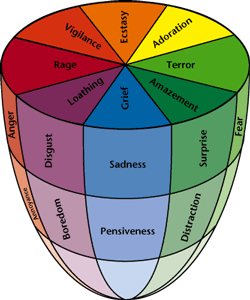
The “academic” name for my flower is Plutchik’s Emotions Model. I am sure most of you have come across it in school if you had any psychology classes. I have only began to appreciate its value recently.
The single petal of the flower represents a single dimension of increasing/decreasing intensity. For example: serenity, joy and ecstasy represent one dimension of escalating intensity. The opposite petal (grief, sadness and pensiveness) represent the opposite dimension. So in total there are 4 basic opposing emotional dimensions.
The core circle shows how close and yet superficially different are the basic emotions. For example, check how close terror to admiration and amazement!
Most interestingly to me is the complex emotions representation in this model. Complex emotions are shown in the space between the flower petals. Each complex emotion is a result of the basic emotions on both sides. For example, love is a combination of feeling acceptance and serenity.
When you close down the flower you see the relations between the different intensity levels of the basic emotions. You can see how sadness, disgust and surprise are very close in their cores.

What I love most about this model is that it gives you the vocabulary to name you feelings most of the times, especially when your feelings are complex.
The other thing I like about it is that it helps a lot explaining what we perceive as “weird” relationships. For example: it makes sense why some people “admire” someone like Saddam Hussein when you see how easily people can confuse terror with admiration. Or why some express their rage as loathing or hate.
On of the things I still get confused with is whether I feel fear or lack of trust. Why am I uncomfortable with X person? Does she scare me? Or is it a trust issue? Or is the fear caused by the mistrust? It was a relief to me to know that the two are not very much different in their mechanism.
What I find challenging is finding the right Arabic word for each feeling that can easily distinguish the difference in dimension and in density. It is established that some cultures do not really have words for some of the feelings in this model.
My Question: Do you agree with the model? How can it benefit you? Have you ever suffered the confusion between to adjacent dimensions?






